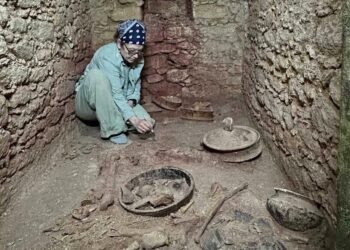A team of Italian and Slovenian researchers has uncovered a rare Copper Age copper dagger in the depths of Tina Jama cave in Italy’s Karst region near the Slovenian border. Led by Professor Federico Bernardini of the Ca’ Foscari University of Venice, the excavation has revealed a rich assortment of ancient artifacts that date back nearly 4,000 years to the Copper Age and early Bronze Age.

The copper dagger, measuring just under 10 cm, was found within a layer of sediment dating back to the late third millennium BCE, a period marked by significant technological, social, and cultural transformations across Europe. The leaf-shaped blade with a tang is exceptionally rare for the region, drawing comparisons to similar artifacts discovered at ancient lake dwellings near Ljubljana, Slovenia.
Professor Bernardini said, “Such discoveries are particularly valuable in Italy and are even rarer in non-funerary contexts like caves.” The resemblance to Slovenian artifacts suggests potential cultural exchanges across the northeastern Adriatic region, revealing hints of interconnected societies during this transformative period.
The excavation at Tina Jama cave, conducted by a collaborative team from the University of Siena, the Slovenian Academy of Sciences’ Institute of Archaeology, and the Abdus Salam International Centre for Theoretical Physics, is part of a renewed effort to explore the region after decades of archaeological inactivity. In addition to the dagger, archaeologists unearthed an extensive array of artifacts, including flint arrowheads, polished stone axes, obsidian tools, ceramic fragments, and shell ornaments.
A statement from Dr. Elena Leghissa of the Slovenian Academy of Sciences underscores the significance of these findings: “The artifacts are essential for understanding the technological and cultural shifts of Europe during the third millennium BCE.” This array of ancient materials suggests that the cave was frequented by various groups over millennia, making it a key site for understanding prehistoric Europe.
One of the most mysterious aspects of the site is a stone structure composed of large slabs and blocks that appears to have been erected to seal the cave entrance between 2000 and 1500 BCE. The structure’s purpose remains uncertain, but researchers speculate that it may have served a funerary function, as fragments of human skulls were found nearby. This evidence points to the possibility of Tina Jama cave being used as a ritual or burial site, a hypothesis that Leghissa and Bernardini support, adding that the discovery “leads us to reconsider the potential role of the cave in prehistoric cultural practices.” Alternatively, the structure may have been constructed to protect the cave’s interior from the strong bora winds common in the region.
The findings also include traces of a hearth, ceramic remnants, and materials associated with the Cetina culture from the Dalmatian region, which dates to the second half of the third millennium BCE. The excavation at Tina Jama cave represents an invaluable opportunity to piece together the early history of the northeastern Adriatic.
More information: Universidad Ca’ Foscari
























